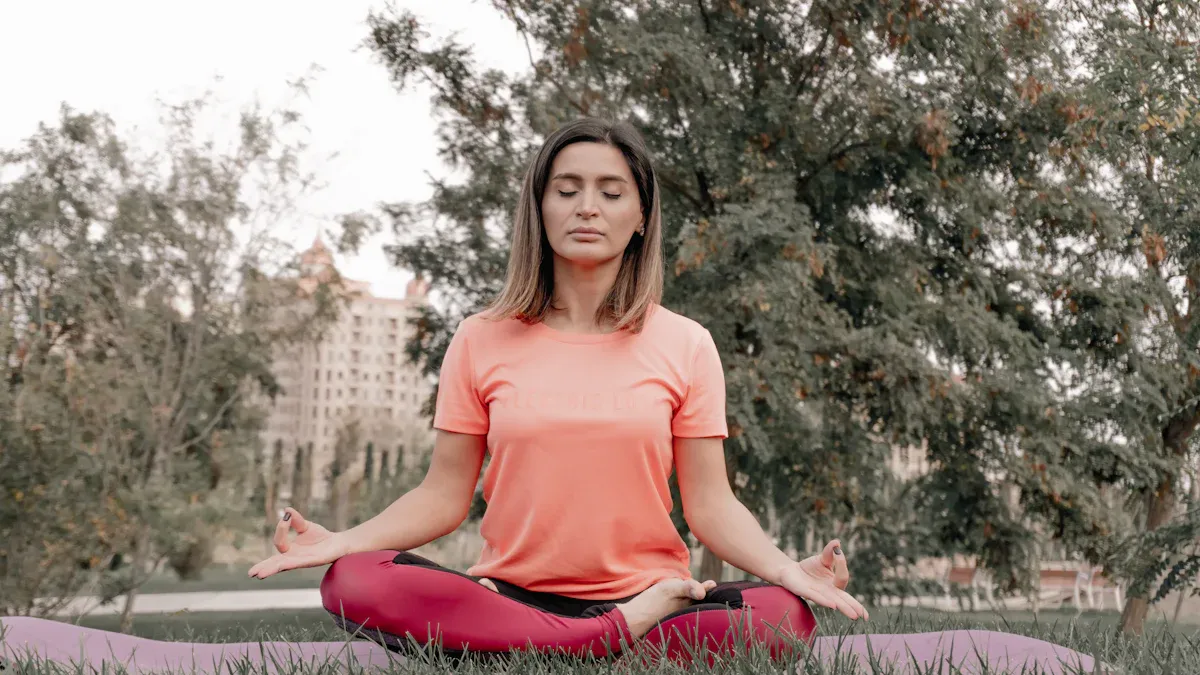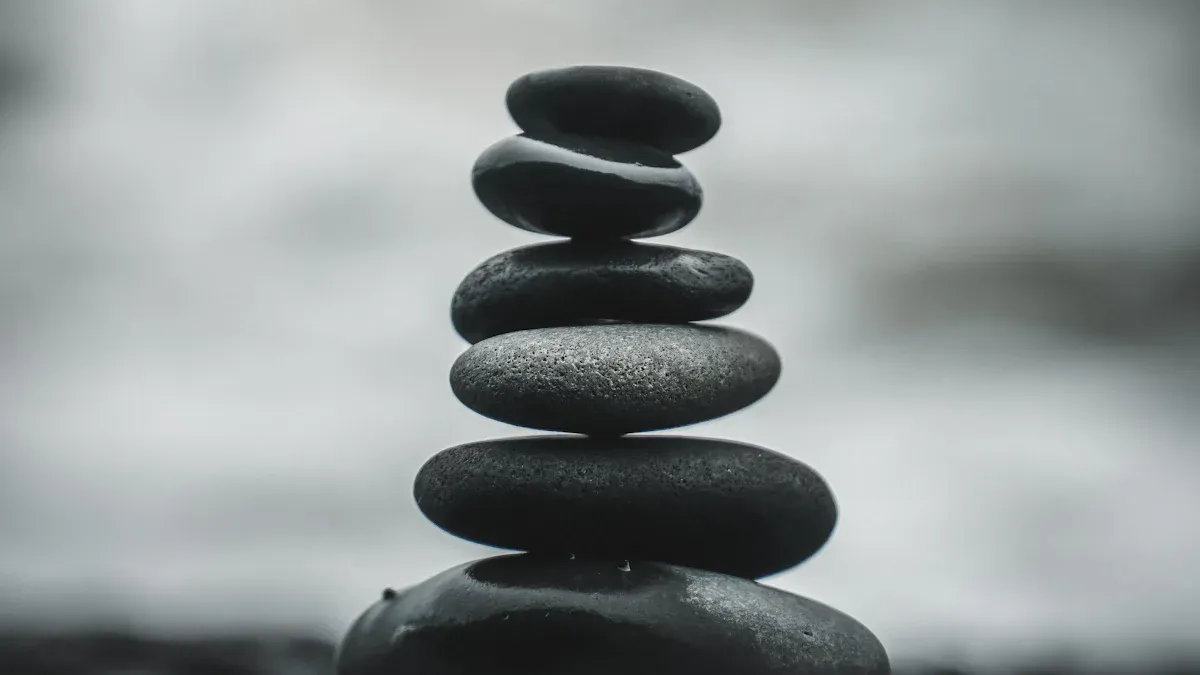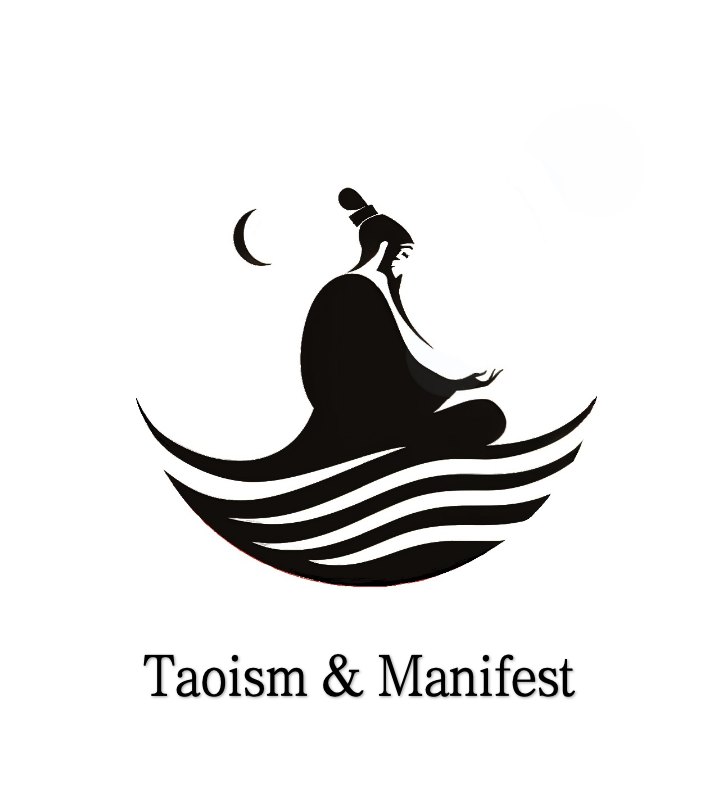
How to reduce stress with mindfulness meditation

Mindfulness meditation is a helpful way to reduce stress. It assists you in staying calm when things get tough. Many adults experience too much stress. Consider these statistics:
Source |
Percentage of Adults Experiencing Stress |
|---|---|
Mental Health Foundation |
74% felt overwhelmed or unable to cope in the past year |
Global Survey (2020) |
38% reported experiencing emotional stress |
Stress in America 2023 |
66% felt they could have used more emotional support in the last year |
You can use simple mindfulness techniques to feel more relaxed and reduce stress. These methods can help you feel more in control. Just a few minutes each day can make a difference. Studies show that mindfulness meditation provides small but significant benefits for stress, anxiety, and mood.
Key Takeaways
Mindfulness meditation helps you feel calm. It lowers stress by making you focus on now. -
Doing mindfulness for a few minutes each day can help a lot. It can make your mood better and lower your stress. -
Find a quiet place and meditate every day. This can help you handle stress better.
What is mindfulness meditation

Core principles
Mindfulness meditation helps you notice what is happening now. You pay attention to your thoughts and feelings. You also notice your body. You do not judge what you notice. This can help you feel less stressed. It can help you feel calm. Here are the main parts of mindfulness meditation:
Key Component |
Description |
|---|---|
Awareness |
You choose where to put your attention. |
Attention |
You focus on your feelings and senses. You do not react. |
Intention |
You know your reason for practicing mindfulness. |
Attitude |
You are kind and curious to yourself. |
Presence |
You stay in the moment and notice it fully. |
Insight |
You learn about yourself by practicing. |
When you use these ideas, you notice your thoughts and feelings. You do not get stuck in them. This helps you stop worrying so much. You can handle stress with more calm and less fear.
Tip: Mindfulness does not mean clearing your mind. It means noticing what is there and letting it be.
Mindfulness vs. other practices
You may wonder how mindfulness meditation is different from other ways to relax. Here are some main differences:
Mindfulness lets you accept your thoughts and feelings. Other methods try to change how you feel.
Mindfulness helps you respond to stress in a thoughtful way. Other methods may just distract you.
Mindfulness can help you react less to emotions. It can help you feel better in ways other methods may not.
Studies show mindfulness meditation helps you manage stress better than some other ways. It can lower anxiety. It can help you stop repeating the same thoughts. It can make tough times easier to handle. If you want to learn more, check out our guide, “Simple Mindfulness Exercises for Beginners”.
How mindfulness meditation helps reduce stress
Interrupting the stress cycle
Stress can feel like a never-ending loop. Your body reacts to challenges by releasing hormones like adrenaline and cortisol. These chemicals prepare you to fight or run away. If you stay stressed, your body keeps making these hormones, which can make you feel tired, anxious, or even sick.
Mindfulness meditation helps you break this cycle. When you practice, you teach your brain and body to pause and notice what is happening. You do not have to react right away. This pause gives your body a chance to relax and recover.
Here is a quick look at what happens inside your body during mindfulness meditation:
Physiological Change |
Description |
|---|---|
Heart Rate Variability (HRV) |
Your HRV improves, which means your body can calm down faster after stress. |
Cortisol Levels |
Your body makes less cortisol, so you feel less stressed. |
Neurotransmitter Levels |
Your brain releases more GABA and serotonin, which help you feel calm and happy. |
You might notice your heart slows down. Your breathing becomes deeper. You start to feel more at ease. Many people who practice mindfulness report feeling less stressed, and their bodies show real changes. For example:
People say they feel calmer after mindfulness training.
Those who feel the most relaxed also show the biggest changes in their bodies.
Scientists see better heart rate patterns during mindfulness exercises.
Mindfulness meditation also changes how your brain handles stress. It helps the parts of your brain that control attention and calm your body work better. At the same time, it lowers the activity in areas that make you feel fear or panic. This means you can reduce stress not just in your mind, but in your whole body.
Note: Even a few minutes of mindfulness each day can help your body recover from stress faster.
Responding vs. reacting
When you feel stressed, you might react without thinking. Maybe you snap at someone or worry for hours. Mindfulness meditation helps you notice these feelings before you act. You learn to respond instead of react.
Your brain changes when you practice mindfulness. The part that makes you feel fear, called the amygdala, becomes less active. The part that helps you think and make choices, the prefrontal cortex, gets stronger. This means you can pause, take a breath, and choose how to act.
Here are some ways mindfulness helps you respond instead of react:
Your brain gets better at controlling emotions.
You feel less fear because the amygdala is less active.
You can think more clearly and make better choices.
You notice your feelings, but you do not let them control you.
This shift helps you reduce stress in your daily life. You start to feel more in control. You can handle tough moments with a calm mind. Over time, you may notice you feel happier and more relaxed.
Tip: The more you practice, the easier it gets to pause and choose your response.
Mindfulness meditation gives you tools to reduce stress, feel better, and live with more peace. Try it for yourself and see how your mind and body change.
Getting started with mindfulness meditation
Creating a quiet space
You want a spot where you can relax and focus. Pick a place that feels comfortable and warm. Good posture helps, so sit upright but stay relaxed. If you can, spend time in nature. Green spaces like parks or gardens help you reduce stress and feel more present. Research shows that being outdoors can boost your mood and help you pay attention better.
Study |
Findings |
|---|---|
Schutte et al., 2017 |
Spending time in natural environments significantly reduces stress. |
Palanica et al., 2019 |
Nature-based therapies improve mental health outcomes. |
Schebella et al., 2020 |
Exposure to green and blue spaces enhances cognitive functioning. |
Try to keep your space free from distractions. Silence your phone and let others know you need a few minutes. You can use a cushion, chair, or even a blanket. The goal is to feel safe and comfortable.
Tip: You do not need a fancy setup. A quiet corner or a spot by a window works great.
Building a daily habit
Starting small makes it easier to stick with meditation. Begin with just 3-5 minutes each day. Choose a regular time, like morning or evening, and use the same spot. Focus on your breath and senses. If your mind wanders, gently bring it back. Celebrate each session, even if it feels short or imperfect.
Here’s a simple guide to get started:
Set aside time—try 20 minutes if you can, but even a few minutes help.
Find a comfortable place and sit with good posture.
Focus on your senses and breathe in and out.
Notice when your mind wanders and return to your breath.
Track your progress and reward yourself for sticking with it.
Many beginners expect instant calm, but it takes practice. Do not fight your thoughts or worry about posture too much. Consistency matters more than perfection. You can use apps like Calm or Insight Timer, or check out books such as "Bliss More" for extra support.
If you want more ideas for simple mindfulness routines, you can read our post, “Simple Mindfulness Exercises for Beginners”.
Mindfulness techniques to reduce stress

You can use different mindfulness techniques to help reduce stress. Each one gives you a simple way to calm your mind and body. Try a few and see which works best for you.
Mindful breathing
Mindful breathing is a great place to start. You focus on your breath and let go of other thoughts. Here’s how you can do it:
Breathe in through your nose, letting your belly rise.
Let your lungs and chest fill with air.
Breathe out slowly, feeling your belly fall.
Repeat this 5-10 times. If you feel dizzy, stop and rest.
You can also count your breaths. Inhale (one), exhale (two), and so on. Try to practice at the same time each day.
Body scan
The body scan helps you notice how your body feels. It can lower stress and help you relax. Start at your toes and move up to your head, paying attention to each part. This practice can lower your stress hormone levels and help your body shift into a relaxed state.
Benefit |
Description |
|---|---|
Activates relaxation |
Helps your body move from stress to calm |
Reduces the main stress hormone |
|
Strengthens body awareness |
Helps you notice how you feel and manage emotions |
Walking meditation
Walking meditation lets you practice mindfulness while moving. You can do this indoors or outside. Nature can make this practice even more powerful.
Stand still and take a few deep breaths.
Start walking slowly, focusing on your feet touching the ground.
Breathe in for a few steps, then breathe out for a few steps.
Keep your attention on your movement and breath for at least 5 minutes.
Walking meditation can improve your mood, help with balance, and support your brain health. Spending time outdoors can boost these benefits.
Being in nature helps you feel more present and relaxed. Many people find that mindful walking in a park or garden makes it easier to reduce stress.
Guided imagery
Guided imagery uses your imagination to create calming scenes in your mind. This can help you relax, sleep better, and even manage pain.
Close your eyes and picture a peaceful place, like a beach or forest.
Notice the sights, sounds, and smells around you.
Stay in this scene for a few minutes, letting your body relax.
Guided imagery can lower your heart rate and help you feel calm. Regular practice can make it easier to relax during stressful times.
Overcoming challenges
Handling distractions
Distractions pop up for everyone, especially when you start meditating. Your mind might wander to what happened yesterday or what you need to do later. You may feel restless or even want to fidget. Some people notice sounds, smells, or even their own thoughts pulling them away from the moment.
You can make things easier by turning off notifications and letting others know you need quiet time. Try focusing on just one sense, like your breath or the feeling of your feet on the floor. This helps you notice when your mind drifts and gently brings your attention back. Practicing mindfulness often makes it easier to return to your focus, even when distractions show up.
Tip: Keep your choices simple. Too many options can make it harder to settle your mind.
Staying motivated
Keeping up with meditation can feel tough some days. You might wonder if it’s working or if you have time. Here are some ways to stay on track:
Set a clear intention before you start. Think about what you want from your practice.
Use your breath as an anchor. Slow, deep breaths help you stay present.
Picture yourself feeling calm and relaxed after meditating.
Repeat a positive phrase or mantra that lifts your mood.
Take one small step each day, even if it’s just a minute.
When it feels difficult
Sometimes meditation brings up tough feelings or feels uncomfortable. You might feel sad, anxious, or even sleepy. That’s normal. Try using relaxation techniques, like gentle stretching or deep breathing, to calm your body. Journaling can help you process your thoughts and feelings. Keeping a daily self-care routine also supports your well-being and helps you set healthy boundaries.
Remember: Every session is progress, even when it feels hard. Be kind to yourself as you practice.
Mindfulness meditation can help you feel less stressed and more calm. It also helps you become stronger when things are hard. You can try mindful breathing for just a few minutes today. As you keep practicing, you will feel more peaceful and stronger inside. Studies show that anyone can get these benefits, no matter who you are. If you keep going, you will see real changes in your life!
Long-term Benefits of Mindfulness Meditation for Stress Reduction |
|---|
Less stress |
Better control of emotions |
Stronger ability to bounce back |
More peace and feeling good |
More kindness to yourself |
Fewer signs of stress and worry |
Less overthinking and less need to push away thoughts |
FAQ
How long should you meditate each day to feel less stressed?
You can start with just five minutes a day. Even short sessions help. Over time, you might want to try longer sessions for more benefits.
Can you use objects to help you focus during mindfulness meditation?
Yes, you can use tools like prayer beads to stay focused. For more ideas, explore Prayer Beads Enhance Focus: Mindfulness Meditation Benefits.
What if your mind keeps wandering during meditation?
That happens to everyone. Just notice it and gently bring your attention back. If you want more tips, check out Using Prayer Beads for Meditation: Focus & Mindfulness Benefits.
See Also
Using Prayer Beads for Meditation: Focus & Mindfulness Benefits





